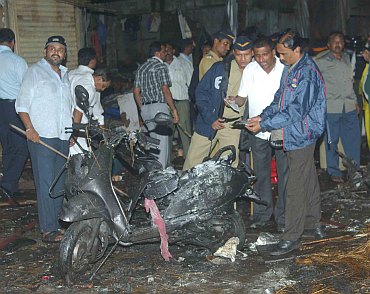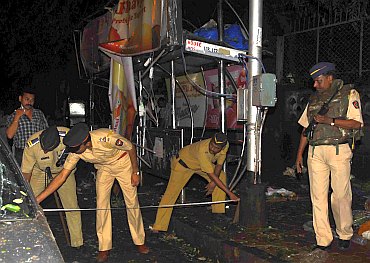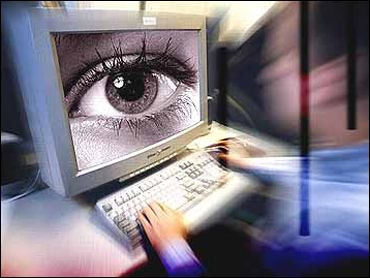Toral Varia in Mumbai
The status of the series of blasts that have occurred in India in the recent past is still 'unsolved'. What are the chances that 13/7 will be solved anytime soon? Toral Varia analyses the odds, with help from counter-terrorism experts.
Let's first look at the chronology of the unsolved blast cases in the recent past to get the record straight.
New Delhi, September 27, 2008: Three people killed after a crude bomb is thrown in a busy market in Mehrauli.
Modasa, Gujarat, September 29, 2008: One killed and several injured after a low-intensity bomb kept on a motorcycle goes off near a mosque. Police claim to have detected the module which executed the blast but the accused are yet to be arrested.
Varanasi, December 7, 2010: Two-year-old girl killed and 25 others injured in a blast which takes place between the Dashashwamedh and Shitla ghats on the river Ganga.
Pune, German Bakery Blast, February 13, 2010: Seventeen people killed and over 60 injured when a bomb rips out Pune's famous German Bakery in the Koregaon Park area.
Delhi, Jama Masji shootout and blast, September 19, 2010: Two gunmen on a motorcycle fired at a tourist bus near Gate 3 of the Jama Masjid in Old Delhi, injuring two Taiwanese tourists. An explosive-laden device was planted in a Maruti 800 car, parked near a transformer near the mosque. The car had approximately 20 litres of fuel in its tank, which would have caused considerable damage if it had succeeded in exploding, but the bomb's timers failed and it did not go off.
Delhi high court, May 25, 2011: The explosion took place around 1.30 pm near a silver Ford Figo car parked outside the court in the lawyers' parking area. The bomb, made of crude explosives and placed in a black cloth bag, went off damaging the bonnet of the car. No injuries were reported.
Bengaluru, Chinnaswamy Stadium, April 17, 2007: The iconic cricket stadium was rocked by two low intensity bomb blasts just an hour before an Indian Premier League match was scheduled to start. The blasts took place in the generator room, which is situated near Gate No. 12 of the stadium. Over 13 people were injured in the blast.
...
'Evidence is being collected in poor and callous manner'
Image: The blast site at Dadar, MumbaiFor those who are looking for the much-anticipated shift in the headline from 'Investigators grope in the dark' to 'Maharashtra ATS cracks 13/7 serial blasts' it's time to get a reality check.
With as many as eight previous blast cases still unsolved, one must not expect the 13/7 Mumbai triple bombings case to be solved anytime soon. As counter-terrorism expert and associate editor of The Hindu, Praveen Swami, puts it, "The manner in which investigations are being conducted and the way in which even basic evidence is being collected is very poor and callous. Investigators state that some groups are 'suspected' to have carried out the blasts. That's not investigation, that's guess work."
Since the early '90s, technical intelligence is fast gaining prominence among the investigators due to its high evidential value. Of late most of the first or immediate leads are generated due to electronic surveillance. From phone-tapping to monitoring call flows, to scanning of close-circuit camera footage to email interceptions, investigators are increasingly becoming dependent on electronic gadgets to lead them to crucial leads or breakthroughs.
...
Pak's involvement in 26/11 was proven due to clinching electronic evidence
Image: Kasab at the Chhattrapati Shivaji TerminusPhotographs: Courtesy: Sebastian D'Souza/Mumbai Mirror
For instance, take the case of the 26/11 attacks. Apart from the fact that Mohammed Ajmal Amir Kasab was caught alive even as the 26/11 attacks were unfolding at three other locations, the only other reason why investigators could conclusively prove Pakistan's involvement in the 2008 terror attacks was due the clinching electronic/scientific evidence.
But in the 13/7 triple bombings, there has been absolutely no detection of any electronic chatter. No interception of any telephonic or internet communication. And as yet, no clear picture has emerged from the lengthy CCTV footage recovered from the blast sites. After scanning through a mammoth over one and a half lakh phone exchanges, some six suspected mobile numbers are now being looked into jointly by Maharashtra, Gujarat and Madhya Pradesh anti-terrorism squads.
The efforts so far haven't yielded any positive results, and further investigations are underway.
With the Indian courts accepting scientific findings as evidence, it's only logical that the investigators have started pursuing electronic leads very seriously. But the fact that the first urge is to look for any electronic chatter is reflective of the fact that technical intelligence is easier to secure, thereby increasing an investigator's dependency on electrical surveillance inputs.
...
'Terrorists have learnt to bypass the system'
Image: The German Bakery at Koregaon ParkPhotographs: Reuters
The scenario in the blasts at Varanasi, Delhi high court, Bengaluru's Chinnaswamy Stadium, Jama Masjid, Pune's German Bakery, is no different. Despite one arrest, it's fair to put the Pune blast in the unsolved category because clearly, all the main suspects are still at large.
In all these cases, the Delhi police, Karnataka police and the Uttar Pradesh special task force seem to have hit a dead end. Despite dipping into their respective library of electronic data for suspected terror group operatives, there has been very little or absolutely no progress in the investigations.
Since 2007, the Indian Mujahideen has claimed responsibility in at least four cases by sending out inflammatory emails to media houses. This time too, out of habit, media houses and intelligence agencies waited for the 'terror email' which never came.
"Terror group operatives have realised that the investigators are highly dependent on sophisticated technology. Terrorist groups have become smart and learnt to bypass the system by making minimum or no use of electronic gadgets," observes Swami.
...
'Cyber crime investigation stops at the computer'
Agencies are quick to trace the area and the internet protocol address that was hacked into to send out the emails. However, there is only so much the investigators can do. With the exception of the arrest of Mansoor Peerbhoy, who is alleged to have sent the email claiming responsibility of the Gujarat serial bombings, investigators have hit a dead end in all the other email investigations.
"The maximum extent to which an investigator goes is to investigate the use of a computer in the crime. In cyber crime we can never get the person. That's where cyber crime investigation stops -- at the computer," says cyber crime and security expert Vijay Mukhi.
Clearly, any investigation into tracing the email can only help investigators get a better idea of 'how' the terrorists went about sending the email, with very little insight into 'who' really sent it.
All well investigated cases prove it beyond doubt that while electronic evidence is important, the first major breakthrough comes from the more traditional route of 'human intelligence'.
...
'Basis of good investigation is good human intelligence'
Image: Fire brigade personnel at the blast site at Zaveri BazaarFormer director general (operations) of Maharashtra, Jayant Umranikar, feels that the basis of a good investigation is good human intelligence. He also stresses on the importance of developing sources for the intelligence agencies rather than individuals, "and one effective way is to hand over the source to the succeeding officer".
Point in case is the manner in which the Gujarat Anti-Terrorism Squad and Mumbai crime branch went about cracking the Indian Mujahideen modules in 2008.
Take the case of the Gujarat serial bombings -- it was the landlord of the premises rented by the 2008 serial blasts bombers, who identified one of the cars used in the bombings. The landlord became the 'source' and the information was promptly shared with the Mumbai crime branch. The latter's officers systematically tracked and interrogated several car thieves before arresting Afzal Usmani and over 19 others.
However, it's due to sheer lack of human intelligence that so many blast cases have been left unsolved. In the case of the 13/7 serial blasts, no doubt the investigators have stepped up the efforts and fanned across eight or nine states, interrogating arrested operatives of terrorist groups, questioning families of suspected operatives, tracking suspects who are out on bail, but that one crucial 'human intelligence' input is missing. Questioning of witnesses, informers or sources, has so far proven to be a futile exercise.
As is the practice with officials, one of the first steps in any blast investigations is to go back to the previous blast suspects, records or intelligence inputs. However, the 13/7 blasts investigators feel that increasingly, home-grown terrorist organisations of the likes of Indian Mujahideen or Students Islamic Movement of India or even the right-wing extremists have started utilising fresh recruits with no criminal record, and that too only once.
...
It's time India's intelligence setup is revamped: Experts
Image: At least 29 people were killed and over 100 were injured as 16 serial bomb blasts rocked Ahmedabad in 2008This makes tracking these suspects even more difficult. In the case of the 13/7 blasts, for instance, the inexperience of the recruits is evident from the absolutely unprofessional way in which the bombs were placed.
Also read: Rain has not washed away evidence
In Gujarat in 2008, every bomb that was placed failed to explode due the faulty assembling of the timer and the explosives. The fact that timers fitted in explosives placed inside the Maruti 800 failed to go off at the Jama Masjid site, also reflects a lack of experience.
Experts feel that it's about time India's intelligence setup is revamped to scuttle terror successfully. Currently, while the Union home ministry has more or less filled in the vacancies in the counter-terror or intelligence agencies, there still is a lot of room for improvement.
"A basic comparative analysis shows that there are a minimum of 1500 agents for just the city of London, while half of that number is sanctioned for the state of Maharashtra. America's Federal Bureau of Investigation has more trained Urdu and Pashto-speaking agents than our agencies," notes Praveen Swami.
Junior-ranking officials that this correspondent spoke to also feel that most of the time they are deputed on political intelligence gathering assignments, as a result of which many treat state intelligence department postings as a punishment.
Given all this, it's very likely the July 13 Mumbai serial bombings to go the way of the other terror attacks before it. Case open but unsolved.







article